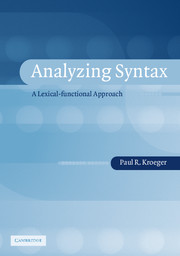Book contents
- Frontmatter
- Contents
- Preface and acknowledgments
- List of abbreviations
- 1 Three aspects of syntactic structure
- 2 Identifying constituents and categories
- 3 Passives, applicatives, and “Dative Shift”
- 4 Reflexives
- 5 Control
- 6 Pragmatic functions: topic and focus
- 7 Filler–gap dependencies and relativization
- 8 Causative constructions
- 9 Serial verbs and related issues
- 10 “Quirky case” and subjecthood
- 11 Syntactic ergativity
- References
- General index
- Language index
7 - Filler–gap dependencies and relativization
Published online by Cambridge University Press: 05 June 2012
- Frontmatter
- Contents
- Preface and acknowledgments
- List of abbreviations
- 1 Three aspects of syntactic structure
- 2 Identifying constituents and categories
- 3 Passives, applicatives, and “Dative Shift”
- 4 Reflexives
- 5 Control
- 6 Pragmatic functions: topic and focus
- 7 Filler–gap dependencies and relativization
- 8 Causative constructions
- 9 Serial verbs and related issues
- 10 “Quirky case” and subjecthood
- 11 Syntactic ergativity
- References
- General index
- Language index
Summary
A Relative clause construction is a noun phrase which contains a clausal modifier. For example, the subject NP in sentence (1) consists of a determiner (the), the head noun (woman), and a modifying clause (I love). The modifying clause is introduced by a Relativizer (that).
(1) [The woman [that I love]s′]NP is moving to Argentina.
Note that the modifying clause in this example seems incomplete: it lacks a direct object, even though its verb (love) requires one. Nevertheless, this sentence is perfectly grammatical. We can give an intuitive explanation for this fact by suggesting that the head noun woman is “understood” to be the object of love. Another way of expressing this intuition is to say that the modifying clause contains a “gap,” while the head noun is interpreted as the thing which fills this gap, making the sentence complete.
In English, this kind of “filler–gap” structure is also found in content (or Wh-) questions and several other constructions, such as clefting and topicalization (i.e., the Contrastive Topic construction). Constructions of this type have some unique and interesting properties, which have stimulated a great deal of syntactic research. One characteristic property of these constructions is that the “filler” may be very far from the “gap.” In English Wh- questions, for example, the question word may occur an arbitrarily long distance away from the verb which assigns its semantic role and grammatical relation.
Information
- Type
- Chapter
- Information
- Analyzing SyntaxA Lexical-Functional Approach, pp. 165 - 191Publisher: Cambridge University PressPrint publication year: 2004
